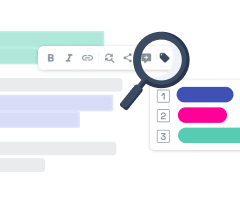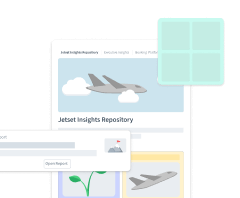
MyTutor Supercharges Their Research Process by Implementing Condens

The Challenges
- Research and data were siloed, resulting in duplicate work.
- Accessing data was inefficient and frustrating.
- Research analysis was time-consuming and tedious.
The Solution
- A single source of truth for getting answers to research questions.
- A robust taxonomy with feedback tags and classifications.
- A secure, GDPR-compliant customer database.
- A streamlined and intuitive research analysis workflow that leverages automation for tedious tasks.
The Implementation
- 10 key steps MyTutor took to ensure a successful implementation.
About the company
MyTutor is an online tutoring platform that works with a diverse customer base of tutors, students, parents, teachers, and schools. Their mission is to make life-changing learning opportunities available and affordable to everyone by matching students on MyTutor’s platform with top university tutors in the UK.
As the MyTutor team began to unite around their mission of making a positive impact on students, they realized that having one source of truth to house all their research and data was an important step toward securing a united front. Upon finding Condens as their ideal solution, Lily Donnelly, Anna Collini (Senior Product Designer), and the MyTutor team pulled off an absolute masterclass of how to successfully implement a research repository. Read on to find out how they did it!

The Challenges
Before implementing Condens, MyTutor faced the challenges of having disorganized, siloed research that was difficult to access, and a data analysis process that was extremely time-consuming. Recognizing these challenges, MyTutor sought a single source of truth to help optimize their data management and improve their overall efficiency.
Research and Data Were Siloed
Before Condens, MyTutor stored their data in Google Drive and Confluence. This eventually devolved into a messy solution as different teams created isolated folders that were difficult to access. And the longer they maintained this setup, the more insular their data became, resulting in a higher risk of creating duplicate work.
„It was very clear that we really needed to optimize the way that we were working and make it more efficient. To make the most of all the research we knew we had, but couldn't necessarily access in the best way.“
Accessing Data Was Inefficient
Whenever someone needed to access existing research that had been created and stored by another team, they needed to go through a “gatekeeper” who knew where specific files were located. This was very inefficient, especially when they needed something quickly. And it also strained their team’s capacity by adding another task to their colleague’s to-do list whenever anyone needed to find existing research.
Research Analysis Was Very Time-Consuming
According to Lily, analyzing user research data used to be incredibly time-consuming. On average, she would conduct 30 user research interviews per term and would need to manually transcribe and analyze all of them while going back and forth between the transcript and recording to find quotes. This was especially tedious when she worked on focus group interviews, which tended to be an hour to an hour and a half long, and involved several speakers.
The Solution
As Lily so eloquently put it, “When you discover something about one customer segment or one part of your audience, you’ll likely be able to uncover insights about another one or start asking better questions as a result. And having access to all the available research in one place is key to tying all those insights together.”

A Single Source of Truth
Since MyTutor implemented Condens as their research repository, it has become their single source of truth and one-stop shop for getting answers to research questions. This has helped them streamline how they search for and use research to validate and amplify the voices of their customers when making business decisions.
According to Lily, the most noticeable change is that she is now able to see research that she never noticed before, such as data on how different products are tested and how other teams conduct research. Having all this information in one place makes enriching their insights and building on existing research much easier.
A Robust Taxonomy
MyTutor wanted a simple search engine that would enable them to organize all their existing and future user research into a consistent format. To accomplish this, the research team worked together with various product squads to build a robust taxonomy with feedback tags and classifications. The data science team also played a crucial role in developing the taxonomy by making sure that no duplicate tags were created. Now everyone who performs research or uses it can easily access and engage with it.

A Secure Customer Database
Because MyTutor works with sensitive customer data, they needed a secure customer database. Condens ensures that their customer data is safeguarded according to GDPR-compliant standards, and stored exclusively in data centers within the EU.
A Streamlined Analysis Process
MyTutor’s researchers use features such as Condens’ automated transcripts, video clustering capabilities, and AI summaries of Highlights and Artifacts to get into a workflow that makes analyzing user research much more intuitive. Saving them a lot of time on research analysis as a result.

Lily estimates that Condens has helped them get back approximately 17.5 working hours per employee per term, and has made a real impact on how quickly and effectively they are able to engage with data and analyze findings.
Real-Life Application
MyTutor holds round tables every term with their Customer Advisory Board. During these round tables, they take the opportunity to gain insights and receive feedback on their most recent projects and initiatives to get a better idea of what should be prioritized.
Before Condens, these round table meetings were recorded and turned into Google transcripts for subsequent analysis. And Lily needed to go back and forth between the transcripts and videos in order to find the right places in the video to cut and edit snippets that she would include in slide decks and presentations. This whole process took a significant amount of time but was considered a worthwhile task because using video snippets is a great way to make findings more engaging and relatable to the audience.
With Condens, this entire process is significantly simpler and faster. Once recordings are uploaded to Condens it’s very easy to find connections and themes across different projects, create Highlight clips, and cluster them together.
Then all that’s needed is to drag and drop the cluster into a report, and they’re ready for use. Streamlining this process has enabled Lily and the MyTutor team to turn out insights a lot faster and “supercharged” how they use the insights from the round table meetings.
„Being able to house everything from the Customer Advisory Board meetings within one project made it really cool. As soon as the recordings were all in Condens, I found it very easy to draw those links and reference things we’d actually heard before in a different context. So I think it supercharged how we were able to leverage those insights.“
The Implementation
Successfully implementing Condens began even before MyTutor decided that it was the solution to their problems.
Check out the 10 key steps MyTutor took to ensure a successful implementation!
Consulted Stakeholders - MyTutor consulted their internal stakeholders, including their product team, engineering team, and various other members of the company who conduct research, on what they felt was needed in a research repository. This was essential to secure team buy-in because nobody likes to be surprised with a new tool that they feel pressured to start using. They made sure that people were not only included but also felt included in the decision-making process.
„You have to make sure that people are included and feel included, which I think are two different things.“
Scheduled a Consultation - Lily scheduled an onboarding call with Mati Rivieccio Vega, one of Condens’ Customer Success Managers, and worked with her extensively throughout the implementation process. Lily also invited a number of product designers to join the onboarding call because she knew that their expertise was important in order to understand how Condens would work for them and the company. And Mati was able to answer all of their questions during the call.
Aligned with Ops - They made sure that their Business Operations team (who is responsible for streamlining all the tooling that is used internally) was on board with getting a new research repository. Lily and her colleagues on the research team walked the BizOps team through Condens and also made sure to justify the return on investment they would get by using Condens to optimize processes.
Made Auditing Easy - They made it really easy to audit existing research and upload or link it to Condens with specially designed project templates. They also let each team decide for themselves what they thought belonged in the library. Giving them the assurance that they are the ones in control of how they use the tool, and allowing them to prioritize the auditing process based on their existing workloads.
Prepared Helpful Assets - Lily and the MyTutor research team worked together to build out a taxonomy, project templates, how-to guides, and even a catchy jingle to get people used to the idea of using Condens. They created their taxonomy with both Global tags and Project tags and got their data team involved to make sure that everything was aligned with their metric goals and that there weren’t any duplicate tags.
Welcomed New Users - All new Condens users received a welcome message, how-to guides for using Condens, and the assurance that Lily and her colleague Anna were available for questions should they arise.
Facilitated Company Engagement - Prior to implementing Condens, they created a research library task force to support with auditing and uploading research. This enabled them to upload comprehensive insights across all four of their distinct customer groups.
Recruited Champions - After implementing Condens, they recruited 12 additional champions (for a grand total of 24 champions) from various different teams to encourage engagement and feedback about Condens in their respective teams.
Utilized Integrations - They made great use of Condens’ Slack integration to bring Condens into their workspace. Using it to share new research and facilitate engagement with Condens.
Kept Condens Top-of-Mind - They proactively mentioned Condens whenever relevant opportunities arose. For example, if a discussion about a customer problem came up, they would point out that there was a report in Condens that could provide valuable insights.
„Repetition is key to adopting a behavior and developing a habit. And people just need a bit of encouragement sometimes.“
Final Advice
As a final piece of advice, Lily stresses the need to focus on getting everyone’s buy-in when implementing a new research repository. Nobody likes surprises, so making sure that everyone is included, and actually feels included, in the implementation process is incredibly important. This will help lead to healthy adoption and maximize your return on investment.
Want to learn more about UX research repositories? Explore Condens' introductory guide to research repositories, and then check out how to set up an effective research taxonomy that will keep your data organized and easily accessible!




